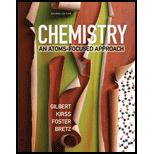
Interpretation & Concept Introduction:
A
a)
b)
c)
Answer to Problem 16.43QA
Solution:
a)
b)
c)
Explanation of Solution
1) Concept:
The known concentration and volume of a weak acid and molarity of a strong base
We can calculate the initial moles of acetic acid using the given molarity and volume. The reaction for the titration of acetic acid and
From the stoichiometry of the above reaction and using initial moles of acetic acid and
Where,
The
The concentration of
The relation for
2) Formula:
i)
ii)
iii)
iv)
v)
vi)
3) Given:
i) Molarity of acetic acid =
ii) Volume of acetic acid =
iii) Molarity of
iv)
4) Calculation:
Calculating the initial moles of
a) Calculating
Calculating the moles of
Set up the RICE table to determine the moles of
| Reaction | + | + | |||||
| Initial | 0 | ||||||
| Change | |||||||
| Final | 0 | ||||||
Since the moles of
Plug in the values in the Henderson–Hasselbalch equation,
b) Calculating
Calculating the moles of
Set up the RICE table to determine the reacted moles of
| Reaction | + | + | |||||
| Initial | 0 | ||||||
| Change | |||||||
| Final | 0 | ||||||
Set up RICE table to calculate the
| Reaction | + | + | |||||
| Initial | 0 | 0 | |||||
| Change | |||||||
| Equilibrium |
Calculating
Calculating the
It is noted that initial moles of acetic acid and moles of added base are equal when
Calculating
Calculating the moles of
Initial moles of acetic acid
Moles of
Set up the RICE table to determine the reacted moles of
| Reaction | + | + | |||||
| Initial | 0 | ||||||
| Change | |||||||
| Final | |||||||
Dissociation of
In the titration of a weak acid vs. strong base, as you increase the concentration of the strong base, the
Want to see more full solutions like this?
Chapter 16 Solutions
CHEMISTRY:ATOMS-FOCUSED..-ACCESS
 ChemistryChemistryISBN:9781305957404Author:Steven S. Zumdahl, Susan A. Zumdahl, Donald J. DeCostePublisher:Cengage Learning
ChemistryChemistryISBN:9781305957404Author:Steven S. Zumdahl, Susan A. Zumdahl, Donald J. DeCostePublisher:Cengage Learning ChemistryChemistryISBN:9781259911156Author:Raymond Chang Dr., Jason Overby ProfessorPublisher:McGraw-Hill Education
ChemistryChemistryISBN:9781259911156Author:Raymond Chang Dr., Jason Overby ProfessorPublisher:McGraw-Hill Education Principles of Instrumental AnalysisChemistryISBN:9781305577213Author:Douglas A. Skoog, F. James Holler, Stanley R. CrouchPublisher:Cengage Learning
Principles of Instrumental AnalysisChemistryISBN:9781305577213Author:Douglas A. Skoog, F. James Holler, Stanley R. CrouchPublisher:Cengage Learning Organic ChemistryChemistryISBN:9780078021558Author:Janice Gorzynski Smith Dr.Publisher:McGraw-Hill Education
Organic ChemistryChemistryISBN:9780078021558Author:Janice Gorzynski Smith Dr.Publisher:McGraw-Hill Education Chemistry: Principles and ReactionsChemistryISBN:9781305079373Author:William L. Masterton, Cecile N. HurleyPublisher:Cengage Learning
Chemistry: Principles and ReactionsChemistryISBN:9781305079373Author:William L. Masterton, Cecile N. HurleyPublisher:Cengage Learning Elementary Principles of Chemical Processes, Bind...ChemistryISBN:9781118431221Author:Richard M. Felder, Ronald W. Rousseau, Lisa G. BullardPublisher:WILEY
Elementary Principles of Chemical Processes, Bind...ChemistryISBN:9781118431221Author:Richard M. Felder, Ronald W. Rousseau, Lisa G. BullardPublisher:WILEY





